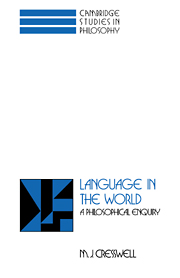Book contents
- Frontmatter
- Contents
- Preface
- Introduction
- 1 A simple formal language
- 2 Predicates and functors
- 3 The isomorphism problem
- 4 Quantification
- 5 Transmundism
- 6 Putnam's ‘Meaning of “meaning”’
- 7 Lewis on languages and language
- 8 Causation and semantics
- 9 Belief–desire psychology
- 10 Direct knowledge
- References
- Index
9 - Belief–desire psychology
Published online by Cambridge University Press: 01 October 2009
- Frontmatter
- Contents
- Preface
- Introduction
- 1 A simple formal language
- 2 Predicates and functors
- 3 The isomorphism problem
- 4 Quantification
- 5 Transmundism
- 6 Putnam's ‘Meaning of “meaning”’
- 7 Lewis on languages and language
- 8 Causation and semantics
- 9 Belief–desire psychology
- 10 Direct knowledge
- References
- Index
Summary
In chapter 8 I argued that the possible-worlds account of causation provided the right model for our everyday explanation of behaviour in terms of beliefs and desires. If possible-worlds semantics is to be justified in the manner advocated by Lewis, as discussed in chapter 7 above, by reducing semantic facts to facts about belief and other propositional attitudes, then it will be necessary to reduce facts about propositional attitudes to facts which do not make reference to content. Both Lewis (1986a, pp. 27–40), and Stalnaker (1984 chapter 1) advocate the reduction of the content of attitudes via belief-desire psychology. Stalnaker contrasts what he calls the pragmatic picture, whereby the ascription of possible-worlds content to attitudes is made directly in terms of the role of beliefs and desires in explaining behaviour, with what he-calls the linguistic picture, whereby the content of attitudes is explained via the content of sentences or sentence-like objects. The linguistic picture is best represented for Stalnaker in Field 1978, so before I discuss the pragmatic picture I shall look at what Field has to say, and what Stalnaker thinks of it.
Field's analysis of
(1) x believes that p
is a conjunctive one. He supposes that when you believe something you are related to a sentence S (or, as he later amends the account, to some kind of representation) which means that p. He calls the relation to 5 belief* and the analysis of (1) is
(2) There exists S such that
(a) x believes*S
(b) S means that p
Initially he accepts that p is a proposition in the sense of a set of possible worlds.
- Type
- Chapter
- Information
- Language in the WorldA Philosophical Enquiry, pp. 128 - 139Publisher: Cambridge University PressPrint publication year: 1994

